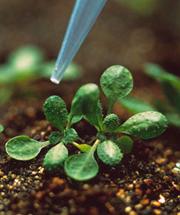 Arabidopsis plants may posses a genetic backup to deal with faulty parental DNA.© SPL
Arabidopsis plants may posses a genetic backup to deal with faulty parental DNA.© SPLIn a discovery that has flabbergasted geneticists, researchers have shown that plants can overwrite the genetic code they inherit from their parents, and revert to that of their grandparents.
The finding challenges textbook rules of inheritance, which state that children simply receive combinations of the genes carried by their parents. The principle was famously established by Austrian monk Gregor Mendel in his nineteenth-century studies on pea plants.
The study, published this week in Nature1, shows that not all genes are so well behaved. It suggests that plants, and perhaps other organisms including humans, might possess a back-up mechanism that can bypass unhealthy sequences from their parents and revert to the healthier genetic code possessed by their grandparents or great-grandparents.
Robert Pruitt and his colleagues at Purdue University in West Lafayette, Indiana, hit upon the discovery when studying a particular strain of the cress plant Arabidopsis, which carries a mutation in both copies of a gene called HOTHEAD. In mutated plants, the petals and other flower parts are abnormally fused together.
Because these plants pass the mutant gene on to their offspring, conventional genetics dictates that they will also have fused flowers. Not so: Pruitt's team has known for some time that around 10% of the offspring have normal flowers.
Back to the future
“It's really weird.”
Steven Jacobsen
University of California, Los Angeles
Using genetic sequencing, the researchers showed that this second generation of plants had rewritten the DNA sequence of one or both of their HOTHEAD genes. They had replaced the abnormal code of their parents with the regular code possessed by earlier generations.
And when the team studied numerous other genes, it found that the plants had often edited those back to their ancestral form too. "It was a huge surprise," Pruitt says.
The discovery has left geneticists reeling. "It's really quite stunning," says Detlef Weigel, who studies plant genetics at the Max Planck Institute for Developmental Biology in Tübingen, Germany. "It's a mechanism that no one had any idea existed."
And geneticist Steven Jacobsen at the University of California, Los Angeles, sums it up even more succinctly. "It's really weird," he says.
Hidden inheritance
Pruitt and other researchers are struggling to explain exactly how the plants could rewrite their genetic code. To do that, they need a template (a version of their grandparents' code) that can be passed from one generation to the next.
One possibility is that the plants use an extra copy of a gene perched elsewhere in their DNA. But this seems unlikely, because the team found that the plants can rewrite the code of genes that have no similar copies elsewhere in the genome.
Instead, Pruitt speculates that the plants carry a previously undiscovered store of the related molecule RNA, that acts as a backup copy of DNA. Such molecules could be passed into pollen or seeds along with DNA and used as a template to correct certain genes. "It's the most likely explanation," Weigel agrees.
Stressed out
Pruitt speculates that this type of gene correction goes on in Arabidopsis under normal conditions, just very rarely. He suggests that it is ramped up when the HOTHEAD gene is mutated, perhaps because the plant becomes stressed.
Indeed, the process could exist because it helps plants to survive whenever they find themselves in difficult condition, such as when water or nutrients become scarce. Such stress could trigger plants to revert to the genetic code of their ancestors, which is perhaps more hardy than that of their parents. To test this, Pruitt is examining whether stressful situations do indeed prompt the same phenomenon.
ADVERTISEMENT
A similar process might even go on in humans. This is suggested by rare cases of children who inherit disease-causing mutations but show only mild symptoms, perhaps because some of their cells have reverted to a normal and healthier genetic code.
If humans do correct their genes in this way, Pruitt suggests that the procedure might be usefully hijacked by researchers or doctors. They might be able to identify the RNA molecules that carry out the repair and use them to correct harmful mutations in patients.
But for now, Pruitt and other researchers in the field are expecting the paper to prompt a lot of scepticism. "The immediate response is that they must have made a mistake," Weigel says, "but I don't think so."
University of California, Los Angeles
